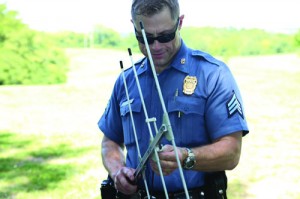Northeast News
Aug. 18, 2014

KANSAS CITY, Missouri — The Kansas City Police Department has added another tool to help them protect and serve the community.
The care trak system allows officers to locate people who have diminished mental capacities, including those who suffer from autism, traumatic brain injuries, Alzheimer’s and dementia. The tool was purchased by the Police Foundation of Kansas City for $10,000. The money was donated the day after a five-year-old boy with autism went missing in Cass County and was found dead in a pond. The KCPD is the first agency in the metropolitan area to deploy Care Trak.
In a press release describing how the tool works, users of Care Trak wear a rugged bracelet on their wrist or ankle. If they wander away from home, police use radio telemetry to track them down. A hand-held antenna in the bracelet alerts officers if they are getting “hotter” or “colder” as they get nearer to or farther away from the missing persons. Radio telemetry is more accurate and inexpensive than GPS technology.
Each of the department’s six patrol division stations will have a tracking unit. A dozen officers have undergone training to use the system, and they will train other officers and detectives at their stations. The Care Trak bracelets cost about $300 initially, with an additional fee of about $3 a month. Police are working to secure donations to help residents pay for them. Medicaid also offers waivers to help caregivers buy them.
The KCPD is encouraging anyone with a loved one who suffers from a disease or disorder that makes them prone to wandering to use a Care Trak bracelet. Sergeant Brad Deichler, one of the officers being trained to operate the device, said in the release he uses the bracelet for his autistic son.
“I’m part of a national network that sends out alerts when a child with autism wanders off,” Deichler said. “About 10 to 15 percent of the time, the child dies. I’m confident it will save lives.”
















